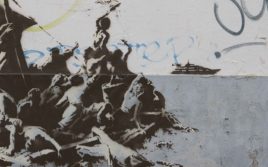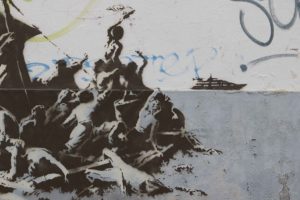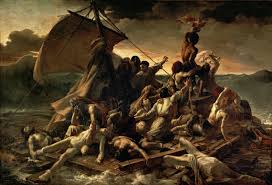Transcript
Why and how should we interpret visual art?
With a vast historical sweep – from early medieval art on the walls inside the Basilica of San Vitale to Banksy’s 2015 stencils of shipwrecked refugees on walls in Calais, by way of Caravaggio, Nevelson and Rothko – author, artist and film maker Gillian McIver looks at various theories of art criticism and helps us understand how to approach visual art.
This lecture was part of series on Thinking put on by the IF Project, the free university in London. IF is an innovative project offering free humanities courses to young people who have been priced out of today’s higher education market.[We have another podcast from the IF lecture series, looking at the relevance of studying history: here.]
Gillian McIver starts from the premise that
“The most important mechanism for interpreting visual art is your own eyes and your ability to really see and to really look…..Go, stand in front of the work of art, literally, physically, look at it. Walk around it, look at its texture, look at its colour…”
She goes on to explore how different approaches in art criticism can inform what and how we look. She considers traditional ways of looking at art (eg the historical approach, looking at historical periods) looking at influences and techniques, artistic movements, looking at the artist, and looking at the times in which the artist lived, the cultural and social environment in which the artwork operates.
Artworks considered are:
- Basilica of San Vitale Medieval
- Hans Memling: Virgin with the child and angel (National Gallery, London) Late Middle Ages
- Titian: Bacchus and Ariadne (National Gallery, London) Renaissance
- Claude: A Seaport (National Gallery, London) Baroque period.
- David: Oath of the Horatii (Louvre, Paris)
- John Singleton Copley The Death of Major Pierson 6 January 1781 (Tate Britain, London) History Painting
- Also mentioned Henry Osawa Tanner – first major black artist in European tradition
- Caravaggio: The Supper at Emmaus (National gallery London)
- Caravaggio Supper at Emmaus (Milan)
- Mark Rothko: Black on Maroon (Tate Modern, London)
- Louise Nevelson: Black Wall (Tate Modern, London)
- Also mentioned Robert Rauschenberg (forthcoming Tate Modern exhibition December 2016 – April 2017)
- Nazeer Tambouli – site specific art on housing estate
Tags: Art criticism, Banksy Calais, Baroque art, Basilica of San Vitale, Caravaggio, Hans Memling, Louise Nevelson, Mark Rothko, Medieval art, The Renaissance, Titian




Subscribe with…